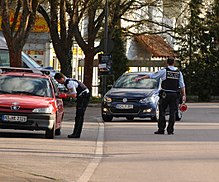Vehicle inspection


A vehicle inspection is the umbrella term for the implementation of a vehicle inspection by law enforcement officers from various authorities. It has either the reason for traffic monitoring or the objective of public safety , with different standards being relevant. It differs significantly from personal control , especially with regard to the intrinsic safety measures .
The most common and best-known are vehicle controls in road traffic by the police. There are also vehicle controls in other areas and by other bodies, e.g. B. in road haulage the Federal Office for Goods Transport or in other areas such as aviation and shipping. This article is related to road traffic.
Situation in Germany
Legal basis
The vehicle inspection has the following legal bases:
- Traffic control according to § 36 of the road traffic regulations
- Police control according to police law , e.g. B. for the Federal Police the Federal Police Act
- Control body (investigation in criminal proceedings ) according to Section 111 Code of Criminal Procedure (StPO)
- Customs control acc. Tax Code
- Border control at international borders by the police
- Identity determination according to the StPO / OWiG
The legal bases mentioned can also partially overlap, see double-function measure . There are different intentions for a vehicle inspection, e.g. B. the prosecution of criminal offenses and administrative offenses (relevant here: identification ), the averting of danger , administrative and enforcement assistance and in rare cases requests for support from other police stations.
execution
A vehicle check is almost always carried out by the police or customs with the support of an emergency vehicle . Large-scale checks are carried out by means of a stand check , also a tactical term. In the individual service , vehicle checks are carried out on the basis of an individual decision, e.g. B. unsafe driving style (see inability to drive ).
One tactic is the so-called Hamburg model : the person who is safe appears first at the vehicle, so that the occupants are distracted, and only then does the officer appear at the vehicle. The advantage of this procedure is that only one officer (the security officer) is at risk and that he or she already has an overview of any weapons that may be carried.
In the case of police orders in Germany, an objection has no suspensive effect ( Section 80 (2) No. 2 VwGO ), i. In other words, a citizen must first obey the instructions of the police. The measure can be reviewed via legal remedies within the framework of the administrative courts .
Within the Schengen States for the police in accordance with Art. 41 of the Schengen Convention of 1990, a pursuit of suspected of a crime km up to 30 possible over its own territory also. However, this only applies to overland routes and to uniformed police vehicles. Example: A very drunk driver drives from Germany to Austria; the German police patrol may stop him on Austrian territory within this zone.
Content
The contents of a vehicle inspection include: The verification of ID cards as well as the verification of people and the things carried. It may also include a search .
Term in Switzerland
The vehicle inspection is a Swiss facility for the technical examination of motor vehicles for road safety , comparable to the German organizations TÜV , DEKRA , KÜS , GTÜ and others, insofar as they technically inspect vehicles. The test is carried out by the road traffic office of the respective canton .
Individual evidence
- ↑ Fabian Toros, Pascal Förster: Legal questions about vehicle controls and inspection days . In: Deutsches Polizeiblatt . No. 6 , 2018, p. 18th ff .
